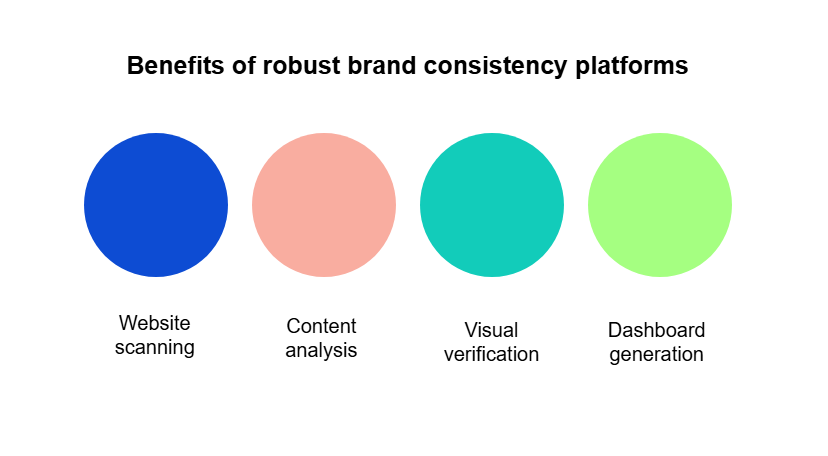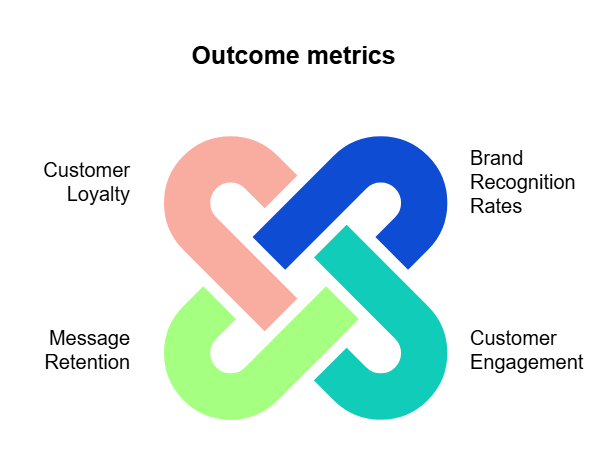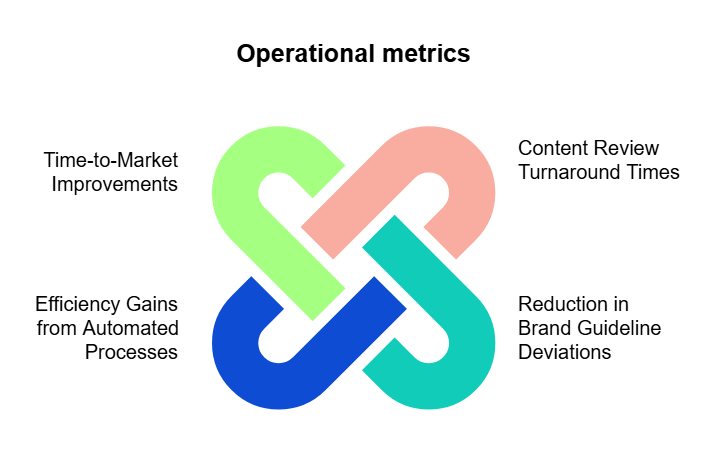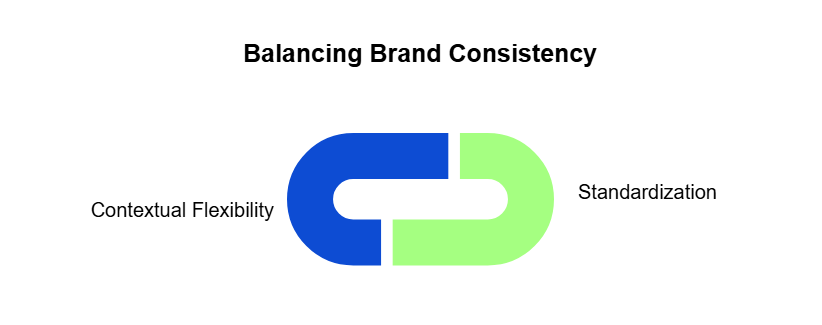Brand consistency is the thread that weaves together every interaction a customer has with your company. In the best-case scenario, your customer is on the receiving end of a cohesive, familiar experience that builds trust, regardless of where those interactions take place. Worst-case: They’re subjected to a jarring, inconsistent experience every time they encounter your brand, and the discrepancies prompt them to take their business elsewhere.
Brand strategy gets increasingly complex every year with the proliferation of marketing channels, decentralized content creation teams, and the sheer volume of content required to maintain a competitive presence.
But it’s also never been more important. When customers receive consistent messaging, they develop clear expectations, affinity, and trust for your brand. Deloitte research shows that 88 percent of customers who trust a brand will buy again, and that trusted companies outperform their peers by up to 400 percent in market value.
Anyone who works in marketing will tell you that consistent messaging (and graphics) is easier said than done. Often the real issue lies in siloed teams: getting everyone on the same page, every day, on every channel, both internally and externally, can be very difficult, particularly for organizations with distributed teams.
As we unpack all this, keep in mind the difference between brand identity (how a company defines itself) and brand image (how consumers perceive the brand). The ultimate goal of brand consistency is to align the two, so your intended identity matches your audience's perception of it.
Building brand consistency, step by step
Winning at brand consistency across multiple channels and teams requires strategic planning and systematic execution. Here’s how, from the ground up.
First things first: Conduct an audit
If you’ve decided it’s time for a brand overhaul, it’s tempting to get started on building anew right away. While that’s exciting, it misses a critical step: a comprehensive brand audit. This means looking closely at all existing brand touchpoints and assets, including visual elements, messaging, digital properties, and customer interactions, so they can all be refined holistically later.
Start by establishing clear evaluation criteria based on your brand's goals and values, then systematically analyze each element for consistency, relevance, and effectiveness. Conduct internal interviews with stakeholders and external research via customer surveys, social listening, and competitor analysis. You’ll find invaluable insights into your brand’s strengths, weaknesses, and inconsistencies so you can prioritize next steps by impact and feasibility.
Define your brand’s unique style
If you’ve taken the time to do a thorough audit, it has likely revealed some bright spots and some hard truths about the state of your brand. With those in mind, it’s time to identify (or restate) your core brand foundation: its purpose, values, positioning, and promise.
Extrapolate those into clear visual guidelines, brand voice and messaging frameworks, and examples showing proper brand implementation on different channels (social media, website, email, print materials, etc.). Include examples of proper brand applications and examples of common brand misuses that have been corrected. “Before” and “after” is a great way to visually understand what to avoid.
Voice and messaging frameworks should detail the terminology, and key messages for your brand, with plenty of examples to show off that personality.
Visual brand standards will prioritize maintaining uniformity in all visual elements, including logos, color palettes, typography, layouts, and imagery and photography styles. Design system documentation tools like Figma can help reinforce the consistency needed to create a cohesive visual language and a subconscious connection for your customers.
Those all go into your new brand style guides and communication bibles. A real-world example: Slack’s Copy Principles exist to cultivate a cohesive voice and tone for all company communications, regardless of the channel. (The top principle? “Don’t make me think.”)
Beauty brand Glossier provides an excellent example of consistent visual identity: The company’s minimalist design, pastel color palette, and clean typography reflect a cohesive aesthetic that’s reinforce by its packaging, website, and social media. The brand is instantly recognizable and appealing to its target audience.
Don’t forget accessibility: Your visual identity may be consistent, but if it doesn’t follow Web Content Accessibility Guidelines (WCAG), it’s not accessible to all users. Make sure to include sufficient color contrast, text alternatives for images, and proper scaling of visual elements across devices in your standards.
Centralize asset management and scale with AI
Today’s organizations are moving beyond static PDF guidelines to interactive digital asset management (DAM) and AI-powered platforms that centralize the latest brand assets, rules, and tools. This way, teams always have the most recently approved assets, which drastically cuts the chance of old or inconsistent messaging hitting the market.
Robust brand consistency platforms can also:
- Automatically scan websites, social media, and digital assets for guideline violations
- Analyze text content for tone, voice, and messaging alignment
- Verify visual elements like colors, typography, and spacing against defined standards
- Generate dashboards highlighting consistency gaps across the organization

Get everyone on board with cross-functional brand training
Establishing the standards is one thing. Getting everyone to use them consistently is another. It’s time to go on tour. Host regular training sessions for marketing teams, external agencies, and even departments not directly involved in brand efforts, so they understand the importance of consistency and their role in maintaining it. (More on meeting the unique challenges of cross-channel communications below.)
Salesforce provides comprehensive brand training for all employees, not just those in marketing roles,
Establish governance and content review workflows
Who’s in charge? Edge cases are a fact of life; there will always be reasons to make exceptions to your brand standards. Without a clear hierarchy of roles, responsibilities, and approval workflows for brand management, all these new standards will be for naught.
AI-powered tools can validate content against brand guidelines before human review. These tools flag inconsistencies in tone, messaging, and visual elements to maintain quality and reduce manual effort.
Some manual reviews may be unavoidable, but they often create bottlenecks as content volume increases. Traditional approaches where small brand teams review every piece of content don’t scale well in today's high-velocity marketing environment:
- Decentralized teams often work independently across multiple channels.
- Limited resources make comprehensive content reviews challenging (or impossible).
- Manual processes become increasingly time intensive as content volume grows.
- Subjective interpretation of brand guidelines leads to inconsistent application.
Intelligent marketing automation platforms with built-in brand consistency features offer a scalable solution: They can automatically validate content against brand guidelines, flag potential issues, and provide real-time feedback to content creators.
Monitor, measure, refine, evolve
Now it’s time to measure the effectiveness of all your hard work. This begins with establishing clear key performance indicators (KPIs) that accurately quantify both the outcomes and operational aspects of brand consistency, such as:
Outcome metrics
- Brand recognition rates (measured through surveys)
- Customer engagement across channels (using sentiment analysis tools)
- Message retention and accurate brand association
- Customer loyalty and trust metrics

Operational metrics
- Content review turnaround times
- Reduction in brand guideline deviations
- Efficiency gains from automated processes
- Time-to-market improvements for branded content

Modern brand consistency platforms transform raw data into actionable insights through intuitive dashboards and visualizations. These insights will lead you to important refinements in your guidelines and processes over time.
Conquering cross-channel comms complexity
Let’s return to the thorniest part of the road to brand consistency: cross-channel communications. Here are some of the most common challenges and how to address them.
Decentralized or siloed teams
Challenge: When channel-specific teams operate independently, inconsistencies naturally emerge, even with detailed guidelines. Different teams (e.g., content, social, PR) develop their own interpretations of brand standards, create channel-specific assets without coordination, and optimize for channel metrics rather than brand cohesion. This problem multiplies in large organizations where teams are geographically dispersed or when external agencies manage specific channels.
Solution: AI-powered brand consistency tools offer automated validation accessible to all content creators, regardless of location or department. They flag deviations from brand guidelines in real-time, which prevents bottlenecks in the approval process. Regular brand alignment sessions synchronize messaging across channels, while centralized digital asset management systems ensure all teams work from the same approved assets.
Uneven brand evolution, unclear authority
Challenge: Brands face the dual challenge of evolving their messaging to remain relevant while avoiding customer confusion from too much change. Without clear governance structures, decision-making around brand consistency becomes inefficient, with some areas changing too rapidly while others remain stagnant.
Solution: An integrated marketing communication (IMC) approach with robust governance structures helps to coordinate evolution across all channels. Establish clear roles, responsibilities, and approval workflows that maintain consistency while allowing for strategic innovation. This framework should define which brand elements are fixed and which can evolve, along with processes for managing and communicating changes. When properly structured, communication channels reinforce and complement each other through controlled evolution rather than the brand experience through uncoordinated changes.
Channel-specific constraints
Challenge: Each channel has unique requirements (character limits, image aspect ratios, etc.) and audience expectations. Guidelines must be flexible enough to accommodate these differences while maintaining core brand elements.
Solution: Add channel-specific guidelines to your consistency tools that adapt core brand elements to each channel's unique requirements while maintaining essential brand attributes. Make sure all teams use the same tools. At Siteimprove, for example, we use Figma and Canva to create various assets depending on the channel. Both platforms store things like fonts, buttons, icons, and colors. For anything that’s published on the web, we run it through our own product, Brand Consistency.
Data fragmentation and attribution
Challenge: When customer information, performance analytics, and journey tracking exist in separate systems, creating a cohesive customer experience becomes nearly impossible. This fragmentation makes properly attributing conversions and measuring true ROI across channels extremely challenging.
Solution: Implement a unified data infrastructure that integrates all customer touchpoints and analytics into a single platform accessible to all teams. Cross-channel attribution models can track complete a customer journey rather than isolated interactions. You can create a sense of teams all rowing the boat in the same direction with KPIs that focus on overall brand performance and consistency rather than channel-specific metrics. Achieving a single customer view (unifying everything you know about a customer, such as sales records, customer service interactions, website behavior, and social media, into one profile) is the holy grail for delivering consistent, personalized messaging, and accurately measuring its effectiveness.
Training and tool resistance
Challenge: Established organizational structures and incentive systems often reinforce channel-specific thinking. Some team members may have specialized expertise but lack needed cross-channel skills. Resistance to change is a natural part of process evolution.
Solution: All teams should be trained to focus on integrated marketing principles. Rotation programs where team members learn from colleagues and understand how channels interconnect can help resistant team members along. Realign incentives and goals away from channel-specific metrics and toward cross-functional metrics.
The future of brand consistency: From uniformity to unified experiences
Brand consistency is not just about looking the same everywhere. It means creating a unique, memorable experience with your brand that respects your audience's intelligence. As cross-channel marketing evolves, the most successful brands will strike the right balance between standardization and contextual flexibility.

Brand consistency is ultimately about inspiring trust. When customers encounter your brand across your multi-channel marketing ecosystem and recognize not just visual elements but the consistent values and voice behind them, they develop the confidence to engage more deeply — huge wins for both your marketing team and company revenue.

Reduce manual reviews with AI validation.
Siteimprove Brand Consistency helps ensure consistent, on-brand messaging that engages customers and boosts loyalty.
Request a demo
Matthew Savener
Matt Savener is a 20-year veteran of digital media. After getting his start on the copy desks of newspapers in Omaha and Washington, D.C., he led the Standards team at Upworthy and the Curation team at Medium. Most recently, he was in charge of quality for Freshworks marketing content.
